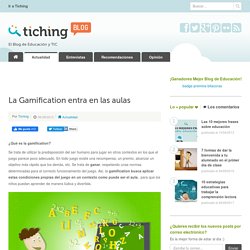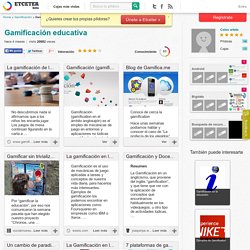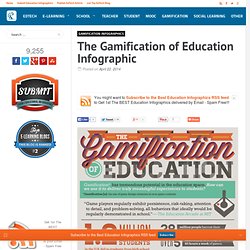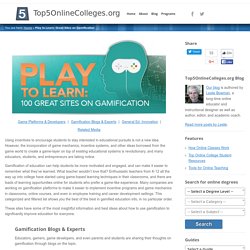

La Gamification entra en las aulas. ¿Qué es la gamification?

Se trata de utilizar la predisposición del ser humano para jugar en otros contextos en los que el juego parece poco adecuado. Fases de diseño y desarrollo de los MOOCs. Gamificación educativa. Castellano Parte Superior / Valencià Part Inferior La semana pasada fui a Olivella (Cataluña) a impartir unos conocimientos sobre la Prehistoria a alumnos de 3º de Primaria.

Y estaréis pensando, pufff, que rollo. Una más que va con los textos y cuatro imágenes a explicar de dedillo las etapas del Paleolítico, el Neolítico y la Edad de los Metales. Pero no. The Gamification Guide for Teachers. El Advergaming no es Gamificación - AdverGaming.Info. Si en el artículo anterior habíamos dicho que el advergaming es una moda, la gamificación es el nuevo virus de la gripe.

Todo el mundo habla de Gamificación hoy en día: empresarios, educadores, marketeros, psicólogos, etc. Y se está extendiendo tanto que, en el Advergaming, puede llegar a crear confusión. Pero el Advergaming no es Gamificación. Quizás lo habrás leído en algún blog, o habrás visto en un vídeo de youtube, o lo habrás escuchado en alguna conferencia. Materiales de “Gamificación en la educación y la formación” Gamificación vs serious games vs simuladores vs juegos vs… Ya habíamos hablado en un post anterior sobre el concepto de gamificación; pues bien vamos a ver algunas figuras con las que tiene la gamificación similitudes, en concreto: diseño gamificado, “serious games”, simuladores y juegos.

Antes de adentrarnos en terrenos doctrinales, aportemos una primera orientación, no sin antes aclarar que muchas veces las fronteras entre estos conceptos son difusas. – Juegos: Los juegos son actividades lúdicas, cuyo principal objetivo es el entretenimiento. Ello no descarta que puedan tener efectos colaterales, por ejemplo la socialización, el desarrollo de capacidades motrices…; pero lo que predomina en ellos es el elemento de “diversión” – Los advergames, son una variante de los juegos, proviene de los términos del inglés advertising y games.Se trata de juegos (mayoritariamente videojuegos) que son utilizados por las marcas para exponer sus productos o servicios. – Gamificación.
Empecemos por este interesante vídeo. Artículos sobre la gamificación en el ámbito educativo. 8 Ways to Use Games in Education. Gamification is found in many contexts these days, but none more prevalent than in the K-12 education environment.

Classrooms are leveraging apps, point systems, leader-boards, badges, and everything between to make their content more dynamic. Truth is, gamification itself is not very new, but the tools that we have available that have increased its popularity, tablets and APIs in particular. With all of the possibilities offered by gamification, it can be difficult to determine the best way to use it. Depending on your use-case, one of the methods below may be ideal. 8 Gamification Strategies As originally detailed by Knewton. 1. The Gamification of Education Infographic. Gamification Infographics Gamification has tremendous potential in the education space.

How can we use it to deliver truly meaningful experiences to students? Vídeotutoriales sobre juegos didácticos. ClassTools.net: Create interactive flash tools / games for education. Play to Learn: 100 Great Sites on Gamification. Using incentives to encourage students to stay interested in educational pursuits is not a new idea.

However, the incorporation of game mechanics, incentive systems, and other ideas borrowed from the game world to create a game-layer on top of existing educational systems is revolutionary, and many educators, students, and entrepreneurs are taking notice. Gamification of education can help students be more motivated and engaged, and can make it easier to remember what they’ve learned. What teacher wouldn’t love that? Enthusiastic teachers from K-12 all the way up into college have started using game-based learning techniques in their classrooms, and there are loads of learning opportunities online for students who prefer a game-like experience.
Many companies are working on gamification platforms to make it easier to implement incentive programs and game mechanics in classrooms, online courses, and even in employee training and career development settings. Gamification frameworks. What are they?

The gamification frameworks are the set of pre-established procedures that serve to gamify a process. In other words, a framework provides us a previously tested pattern that will allow us to gamify a process with greater guarantees of success. Why use them? Using a framework has several advantages: - Having a guide that helps us to order in a logical way our efforts in organizing gamification, this translates into the minimization of errors, which consequently saves the time and money. - Increase our chances of success. Are the frameworks the magic solution? Obviously the answer is no, for the following reasons: - The gamification is not an exact science. . - Obviously it also depends on the framework that we use.
. - The frameworks offer general recommendations which we will have to adapt to the specificities of our concrete situation. This does not mean that we should not use them; on the contrary, they can be of great help. What are the frameworks based on? - Research. Final note.